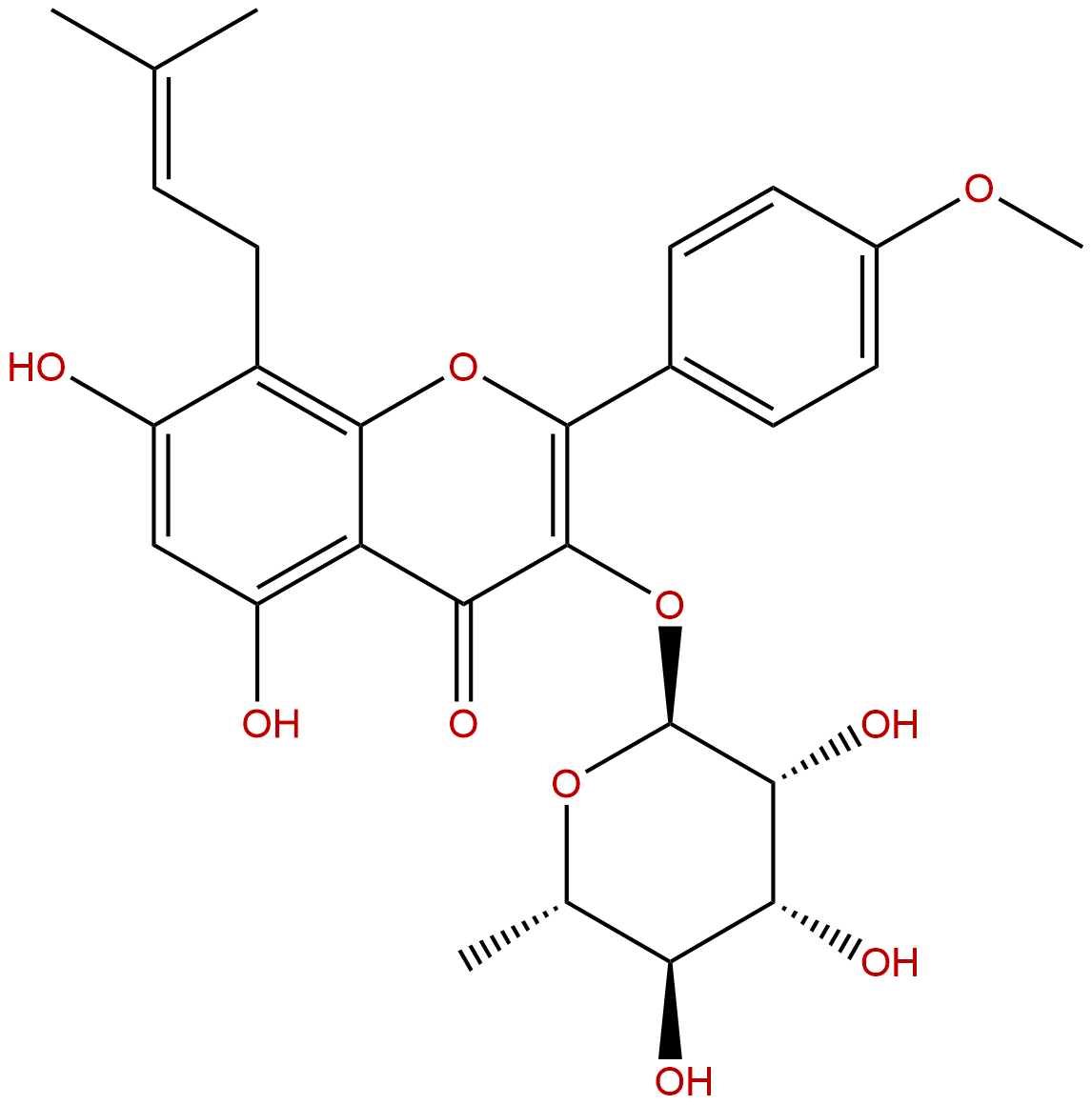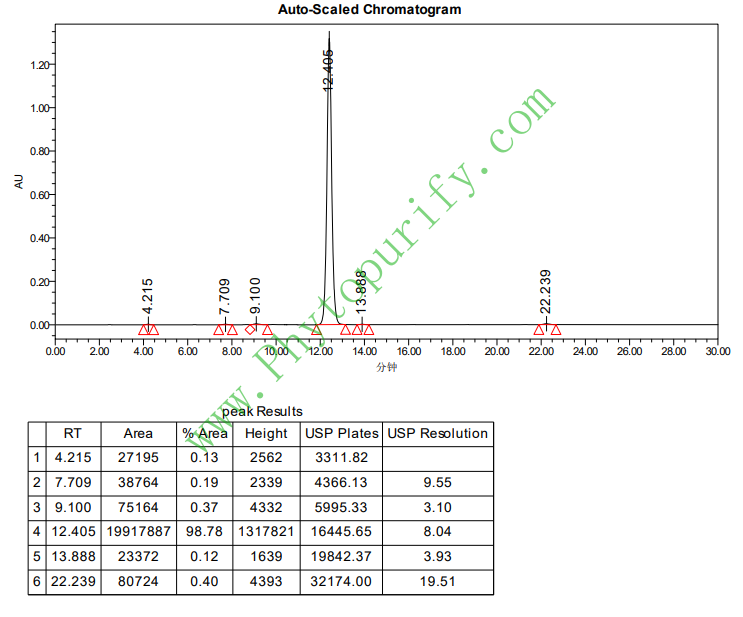
Baohuoside ICAS No.:113558-15-9 |
||||||||||
 |
|
|
||||||||

| Catalogue No.: | BP0236 |
| Formula: | C27H30O10 |
| Mol Weight: | 514.527 |
| Botanical Source: | Epimedii folium |
Product name: Baohuoside I
Synonym name: Icariside II
Catalogue No.: BP0236
Cas No.: 113558-15-9
Formula: C27H30O10
Mol Weight: 514.527
Botanical Source: Epimedii folium
Physical Description:
Type of Compound: Flavonoids
Purity: 95%~99%
Analysis Method: HPLC-DAD or/and HPLC-ELSD
Identification Method: Mass, NMR
Packing: Brown vial or HDPE plastic bottle
Storage: Store in a well closed container, protected from air and light. Put into refrigerate or freeze for long term storage.
Whenever possible, you should prepare and use solutions on the same day. However, if you need to make up stock solutions in advance, we recommend that you store the solution as aliquots in tightly sealed vials at -20℃. Generally, these will be useable for up to two weeks.
The product could be supplied from milligrams to grams
Inquire for bulk scale.
Description:
Baohuoside I is a novel immunosuppressive molecule, exhibits antimetastatic, anti-osteoporosis, anti-inflammatory and anti-cancer activities. Baohuoside I can inhibit the proliferation of Eca-109 cells, this effect associats with down-regulation expression of β-catenin,Cyclin D1,Survivin,and their proteins,which affects on the Wnt/β-catenin signaling pathway.
References:
Chinese Traditional & Herbal Drugs, 2011, 42(1):124-6.
Effect of baohuoside-I on Wnt/β-catenin signaling pathway of human esophageal carcinoma cell Eca-109.
To study the effect of baohuoside-I extracted from Periplocae Cortex on proliferation and Wnt/β-catenin signaling pathway of human esophageal carcinoma cell Eca-109.
METHODS AND RESULTS:
The expressions of β-catenin, Cyclin D1, and Survivin protein in Eca-109 cells were measured with flow cytometry (FCM). The expressions of β-catenin, Cyclin D1, and Survivin mRNA were detected by RT-PCR. After treatment with 25 and 50 μg/mL of Baohuoside I for 48 h, the expression levels of β-catenin, Cyclin D1, Survivin mRNA, and protein were decreased significantly (P<0.01), but with 12.5 μg/ML of Baohuoside I the expression level was not decreased significantly compared with the control group.
CONCLUSIONS:
: Baohuoside I from Periplocae Cortex could inhibit the proliferation of Eca-109 cells. This effect associais with down-regulation expression of β-catenin, Cyclin D1, Survivin, and their proteins, which affects on the Wnt/β-catenin signaling pathway.
Chem Biol Interact. 2012 Jul 30;199(1):9-17.
Reactive oxygen species-mediated mitochondrial pathway is involved in Baohuoside I-induced apoptosis in human non-small cell lung cancer.
Baohuoside I (also known as Icariside II) is a flavonoid isolated from Epimedium koreanum Nakai. Although Baohuoside I exhibits anti-inflammatory and anti-cancer activities, its molecular targets/pathways in human lung cancer cells are poorly understood. Therefore, in the present study, we investigated the usefulness of Baohuoside I as a potential apoptosis-inducing cytotoxic agent using human adenocarcinoma alveolar basal epithelial A549 cells as in vitro model.
METHODS AND RESULTS:
The apoptosis induced by Baohuoside I in A549 cells was confirmed by annexin V/propidium iodide double staining, cell cycle analysis and dUTP nick end labeling. Further research revealed that Baohuoside I accelerated apoptosis through the mitochondrial apoptotic pathway, involving the increment of BAX/Bcl-2 ratio, dissipation of mitochondrial membrane potential, transposition of cytochrome c, caspase 3 and caspase 9 activation, degradation of poly (ADP-ribose) polymerase and the over-production of reactive oxygen species (ROS). A pan-caspase inhibitor, Z-VAD-FMK, only partially prevented apoptosis induced by Baohuoside I, while NAC, a scavenger of ROS, diminished its effect more potently. In addition, the apoptotic effect of Baohuoside I was dependent on the activation of ROS downstream effectors, JNK and p38(MAPK), which could be almost abrogated by using inhibitors SB203580 (an inhibitor of p38(MAPK)) and SP600125 (an inhibitor of JNK).
CONCLUSIONS:
These findings suggested that Baohuoside I might exert its cytotoxic effect via the ROS/MAPK pathway.
Transplantation. 2004 Sep 27;78(6):831-8.
Baohuoside-1, a novel immunosuppressive molecule, inhibits lymphocyte activation in vitro and in vivo.
We evaluated the in vitro and in vivo immunosuppressive effects of Baohuoside I (B1), a novel flavonoid isolated from Epimedium davidii.
METHODS AND RESULTS:
Proliferation assay was used to determine the antiproliferative properties on T-cell and B-cell proliferation. Flow cytometry analysis was applied to detect changes of phenotypes on activated cells. B1 inhibits the lymphocyte proliferation activated by polyclonal mitogens and mixed lymphocyte reaction with a 50% inhibitory concentration of low micromolar concentration. Also, B1 suppressed T-cell activation in T cell receptor/CD3-mediated signaling pathways in a dose- and time-dependent manner. The suppression of B1 was not simply a result of a toxic effect and was recovered by withdrawing the drug. B1 down-regulated the expression of some phenotype molecules. In Ca(2+)-independent or -dependent antigen stimulation, although B1 had different inhibitive patterns on CD69 expression stimulated by phorbol 12-myristate 13-acetate (PMA) or Ca2+ ionophore, it inhibited T-cell proliferation induced by CD3/CD28 or PMA/ionomycin and partially blocked that induced by PMA/CD28. Interestingly, an additive inhibition between B1 and tacrolimus (FK506) was found in the CD69 expression stimulated by PMA/CD28 and PMA/ionomycin. Similarly, this immunosuppression by combination therapy was observed in a heart transplantation model in vivo and might act through an immunosuppressive mechanism different from FK506.
CONCLUSIONS:
B1, whose mechanism of action is not similar to that of FK506, has selectively immunosuppressive effects on T-cell and B-cell activation in vitro and effectively prevents rat heart allograft rejection in vivo.
HPLC of Baohuoside I
